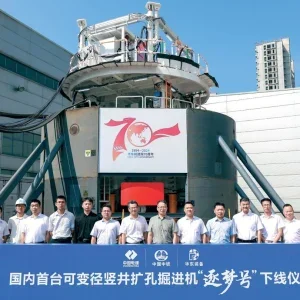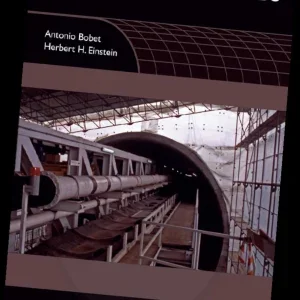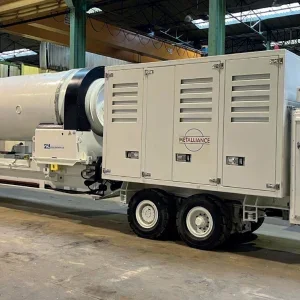Construction work began on the Southern Link at the beginning of 1998 and involved the construction of access tunnels plus a cut+cover section which forms the western approach to the Southern Link. This is an urban motorway, with a speed limit of 70km/h, that will be incorporated in the national road network. Since then, four contracts have been awarded by the client, Vägverket, the Swedish National Road Administration: three for the rock tunnels and one for a cut+cover section connecting the Southern Link with Huddingevägen. The contracts for the remaining sections of the project will be awarded late 1999 and 2000.
It is anticipated that the Southern Link, with the exception of the connection to Nynsvägen, will be opened to traffic at the end of 2003. However, the connection to Nynsvägen, a heavily trafficked feed road into Stockholm (approximately 90 000 vehicles/day), will not be finished until end 2004.
Three firms of consulting engineers have been involved in the project: SCC (Scandiaconsult) designed most of it with the exception of the Sickla section (J & W – Jacobsson & Widmark) and the Nynsvägen section (Stockholm Konsult).
Tunnels
The main tunnels consist of two twin tubes. Each will have two lanes for through traffic and one for access and exiting. The lanes are 3.5m wide; the hard shoulder on the left of the carriageway is 1m wide and the one on the right is 2m. Ventilation in the tunnels will be longitudinal, which means that the one-way traffic tunnel tubes also function as ventilation channels. Under normal conditions, the fans will only be required when traffic is congested or moving so slowly that vehicle momentum is insufficient to push the air forwards. Fans will be positioned at approximately 100m intervals and will also be used to control smoke and combustion gases in the event of an accident.
In order to avoid a concentration of vehicle emissions outside the tunnel entrances, air handling plants will be installed with fans forcing out air through ventilation towers.
Vägverket is imposing stringent demands on the Southern Link contractors with respect to the environmental impact permitted during construction. The contractors are also required to have their own functional routines, a so-called environmental management system for supervising and documenting these requirements.
Vägverket states limits for the maximum acceptable noise (both air transmitted and structure borne) and vibration levels emanating from the construction works and the roads that the contractors use for transport to and from the work site. Furthermore, it has been stipulated that current levels of traffic must be allowed to continue without interruption. According to the Water Rights decree issued by the Swedish Water Rights Court, the work is to be executed in a manner that prevents any damage or permanent changes. This will be primarily achieved by maintaining a stable groundwater table.
Work in the tunnels is performed between 07.00h and 22.00h on weekdays with stricter limits on noise and vibration between 18.00h and 22.00h. Some work on Saturdays is also allowed. Each contractor is responsible for the excavated rock produced. All in all, 2million m³ will be transported away.
Rock tunnels
Construction of the rock tunnels has been divided into four contracts. NCC has been awarded two of these contracts: SL – 01 and SL – 02. It is undertaking the work in JV with its Norwegian subsidiary, NCC Eeg-Henriksen, which has a great deal of experience of tunnel construction in Norway. The total value of these two contracts is $86m and the construction period is October 1998 to September 2001.
NCC is building 2.1km of the Southern Link in its two contracts, involving just over 10km of tunnels. Cross sections vary from 10-140m², with an average of 75m². The work includes eight underground bridges at crossings between ramp tunnels and main tunnels and at the point where the ramp tunnels cross one another. The total volume of rock excavated will be 760 000m³NCC is using one Atlas Copco Boomer drilling rig on each contract, as well as a Tamrock drilling rig on S – L01 and an AMV rig on SL – 02. The excavated material is being loaded by one Volvo BM L330C wheel loader on each contract, machines which were previously used by NCC Eeg-Henriksen on the Laerdal Tunnel in Norway.
A third contract (SL – 03) has been awarded to Selmer Anläggning, which is the Swedish construction subsidiary of Norwegian contractor Selmer. This is Selmer’s first major project as a contractor in Sweden, although the group has had Swedish subsidiaries for some time. The contract value of Selmer’s project is $59m. Work started on this contract in November 1999 and the construction period is three years. When T&T International visited the site, a total of 26 000m³ had been excavated.
Selmer is constructing 2km of the Southern Link in its contract, involving 8.3km of tunnels. Cross sections vary from 20 to 126m² and the total volume excavated will be 700 000m³. In addition to the tunnelling work, this contract includes the construction of surface roads and bridges which will be undertaken simultaneously with the tunnelling work. The company is investing $6.1m in equipment for this contract. It includes four Atlas Copco Rocket Boomer drill rigs, an electro/diesel Brøyt excavator to load the excavated rock on to trucks, and CAT 980 and 988 wheel loaders.
The fourth contract (SL – 04) for 500m of the Southern Link has been awarded to Vägverket Produktion, the construction part of Vägverket. Contract value for Vägverket Produktion’s project is $10.7m and a total length of 1.2km of tunnels is being constructed, involving excavation of 125 000m3 of rock. Work started in August 1999 and the completion date is January 2001.
Concrete tunnels
Concrete tunnels are being constructed where the bedrock above the tunnel is either non-existent or insufficient. This is the case at tunnel entrances where the tunnel approaches the surface. Such tunnels are being constructed in cut+cover. Common to all the different concrete structures is that they lie below the water table, so they must be rendered watertight to prevent groundwater leakage.
Owing to the proximity of existing pipes and buildings, strict requirements have been placed on preventing any lowering of the water table with the ensuing risk of settlement. Different techniques are being implemented for this purpose, among which is sheet piling with jet grouting and curtain grouting.
Two contracts have been awarded for the concrete structures, one to Skanska for the Åbyvägen section and one to Selmer Anläggning for the cut+cover section which connects Södra Länken with Huddingevägen. Work began on this latter contract in February 1999 and the concrete tunnel is scheduled for completion at the end of 2001. Hercules Engineering is the sub-contractors responsible for driving the sheet piling and a JV of Hercules and Trevi is carrying out jet grouting to the sheet piles.
Åbyvägen, the western portal
At Åbyvägen, there are three forms of construction, all forming part of the main motorway: a 140m long section of open cut formed by concrete retaining walls and a base slab; a concrete tunnel built as a cut+cover construction, founded first on piles in the clay (160m) and then on rock (120m); and a short length of rock tunnel (40m).
The main contractor for this work is Skanska, while Skanska Teknik is responsible for the design under a sub-contract. Work started here in November 1997 and will be completed in 2001. Contract value is $45m. An area measuring 420m by 40m has been demarcated with sheet steel piling that is anchored with wire stays. The stays are drilled at an angle of 45° behind the piling down to and into the rock, where they are then cast in position.
Some difficulty was experienced in driving the sheet piles all the way down to the rock in two areas because the moraine could not be penetrated. Here the sheet piling has been reinforced considerably and excavation is currently taking place.
The first 100m had been excavated to the full depth and a 40m length of slab had been poured when T&T International visited the site in May 1999. Excavation is being continued for the full length of the cut+cover construction, including blasting the rock to the required level. Once this has been achieved, work can begin on driving the final 40m of rock tunnel.
A thin layer of moraine overlies the rock at Åbyvägen which in turn is covered by clay that is highly susceptible to settlement. To ensure that no settlement or movement takes place, continuous measurements are being taken from sensors placed on the sheet piles and in the ground. These sensors demonstrate any movement in the sheet piles and the groundwater level and the results can be shown on screen. Both concrete piles and steel core piles – which can take both compression and tension to counteract the upward pressure of the groundwater – are being driven to refusal in the moraine or to the rock.
The project has required an extensive amount of grouting: jet grouting, performed by Keller of Germany, has been used to make the joint between the sheet piles and the rock watertight instead of employing the traditional grouting method. Curtain grouting of the rock has been carried out to a depth of 10m below foundation level. Furthermore, the holes for the wire stays through the sheet piling have to be made watertight, in some cases by repeated grouting.
The second area involving complicated techniques is construction of the concrete tunnel only 4m away from an existing 14 storey apartment block. Because wire stays were not allowed to penetrate among the existing concrete piles of the building and because of the considerable length (35m) of the bracing required, excavation here is being performed in stages.
The first stage, which entailed driving two parallel lines of sheet piling adjacent to the tower block, has been completed. The first line of sheet piling has been driven to the width required to construct the first (and farthest away from the block) of the two adjoining concrete tube structures and the ground is being excavated to the required level within that width. When the first tube structure has been cast, it will be used as a support for bracing the outer line of piling that has been driven to the full width adjacent to the tower block. Excavation and bracing will be carried out in stages until the final level of excavation is reached and the second tube structure can be built. Finally, the excavation will be back filled and the struts removed.
SSE system
The SSE system is based on a factory produced non-explosive emulsion matrix, which is very difficult to ignite and only burns after a large proportion of the water it contains has been removed. The system consists of a charging truck with two charging lines, aluminium storage tanks for the emulsion matrix and a gassing agent, plus conveyance pumps for filling the SSE truck with the semi-finished products. The emulsion matrix and the gassing solution are classified as oxidising substances, which means that the transport, storage and handling of large quantities of explosive goods is avoided.
During charging, the gassing agent is added at the same rate as the drill hole is charged. When the two substances are mixed, small gas bubbles of nitrogen gas are formed in the emulsion. This reduces the density so that the emulsion obtains explosive properties. Within a few minutes, the density is reduced to an area where the explosive Emulite 1100 is obtained and, by regulating the diameter of the blasting agent string, the charging concentration can be optimised. The advantages of this system are increased security and fewer limitations during transport and storage; the fact that charging can be optimised to suit different rock conditions; and the emulsion explosives favourable effect on the underground environment.
Related Files
Location Route Map
Longitudinal Profile
Cross Section
Cross Section of Southern Link






